It looks like you're using an Ad Blocker.
Please white-list or disable AboveTopSecret.com in your ad-blocking tool.
Thank you.
Some features of ATS will be disabled while you continue to use an ad-blocker.
9
share:
originally posted by: 1ofthe9
www.newscientist.com...
Paging JadeStar. Benford beacon type stuff?
From article:
Mysterious radio wave flashes from far outside the galaxy are proving tough for astronomers to explain. Is it pulsars? A spy satellite? Or an alien message?
BURSTS of radio waves flashing across the sky seem to follow a mathematical pattern. If the pattern is real, either some strange celestial physics is going on, or the bursts are artificial, produced by human – or alien – technology.
Telescopes have been picking up so-called fast radio bursts (FRBs) since 2001. They last just a few milliseconds and erupt with about as much energy as the sun releases in a month. Ten have been detected so far, most recently in 2014, when the Parkes Telescope in New South Wales, Australia, caught a burst in action for the first time. The others were found by sifting through data after the bursts had arrived at Earth. No one knows what causes them, but the brevity of the bursts means their source has to be small – hundreds of kilometres across at most – so they can't be from ordinary stars. And they seem to come from far outside the galaxy.
The weird part is that they all fit a pattern that doesn't match what we know about cosmic physics.
Wow this is super cool assuming it's valid!
"We have detected 10 fast bursts of radio waves (FRBs) coming from space over the last fifteen years. The delay between the arrival of the first and last waves of each burst is always a multiple of 187.5. No known natural process can explain this"
"We have detected 10 fast bursts of radio waves (FRBs) coming from space over the last fifteen years. The delay between the arrival of the first and last waves of each burst is always a multiple of 187.5. No known natural process can explain this"
originally posted by: 1ofthe9
www.newscientist.com...
Paging JadeStar. Benford beacon type stuff?
No.
Fast radio bursts are wide-band noise, like the other radio noise natural objects like lightning, the Sun and Jupiter produce.
Nature produces lots of wide-band noise type radio "signals". Fast radio bursts, like pulsars before them are almost certainly produced by some sort of natural object like neutron stars, colliding black holes, etc.
Artificially produced radio signals would be narrow band because they allow the easy encoding/decoding of information.
Narrow band signals are not produced by nature so they'd pop out as not natural even after travelling hundreds of thousands of lightyears. Useful for a beacon.
Fast radio bursts are almost certainly not ET beacons not the result of any sort of intentional transmission.
There have already been several threads in the Space Exploration forum on ATS on Fast Radio Bursts where I discussed this. Most recently, this one.
edit on 1-4-2015 by JadeStar because: (no reason given)
originally posted by: JadeStar
originally posted by: 1ofthe9
www.newscientist.com...
Paging JadeStar. Benford beacon type stuff?
No. Artificially produced radio signals would be narrow band because they allow the easy encoding/decoding of information.
Narrow band signals are not produced by nature so they'd pop out as not natural even after travelling hundreds of thousands of lightyears. Useful for a beacon.
Fast radio bursts are wide-band noise, like the other radio noise natural objects like lightning, the Sun and Jupiter produce.
Nature produces lots of wide-band noise type radio "signals". Fast radio bursts, like pulsars before them are almost certainly produced by some sort of natural object like neutron stars, colliding black holes, etc.
There have already been several threads in the Space Exploration forum on ATS on Fast Radio Bursts where I discussed this. Most recently, this one.
Not if it is using spread spectrum. The point of spread spectrum is to have signals appear as background noise so not to interfere with other signals on the same bands, that is why the early WiFi mandated the use of Spread Spectrum in the early days. They also use Orthogonal codes (in the case of CDMA).
edit on 1-4-2015 by bullcat because: (no reason given)
originally posted by: bullcat
originally posted by: JadeStar
originally posted by: 1ofthe9
www.newscientist.com...
Paging JadeStar. Benford beacon type stuff?
No. Artificially produced radio signals would be narrow band because they allow the easy encoding/decoding of information.
Narrow band signals are not produced by nature so they'd pop out as not natural even after travelling hundreds of thousands of lightyears. Useful for a beacon.
Fast radio bursts are wide-band noise, like the other radio noise natural objects like lightning, the Sun and Jupiter produce.
Nature produces lots of wide-band noise type radio "signals". Fast radio bursts, like pulsars before them are almost certainly produced by some sort of natural object like neutron stars, colliding black holes, etc.
There have already been several threads in the Space Exploration forum on ATS on Fast Radio Bursts where I discussed this. Most recently, this one.
Not if it is using spread spectrum. The point of spread spectrum is to have signals appear as background noise so not to interfere with other signals on the same bands, that is why the early WiFi mandated the use of Spread Spectrum in the early days.
Spread spectrum still contains a narrowband component carrier. (Actually many of them).
See the waterfall plots below to see this visualized:
Normal Radio Signal Doppler Shifted as it would appear to come from space
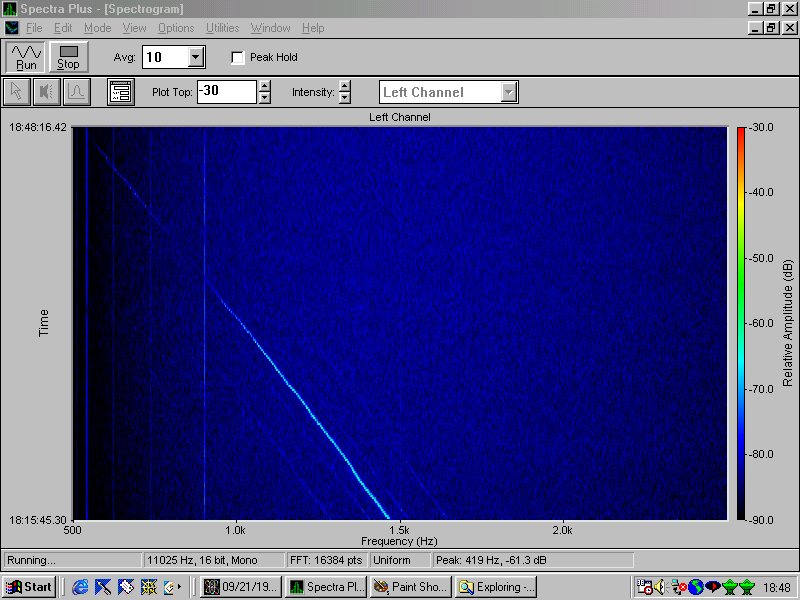
Normal Radio Signal Doppler Shifted from the Voyager 2 space probe

Spread Spectrum Radio Signals from orbiting satellite
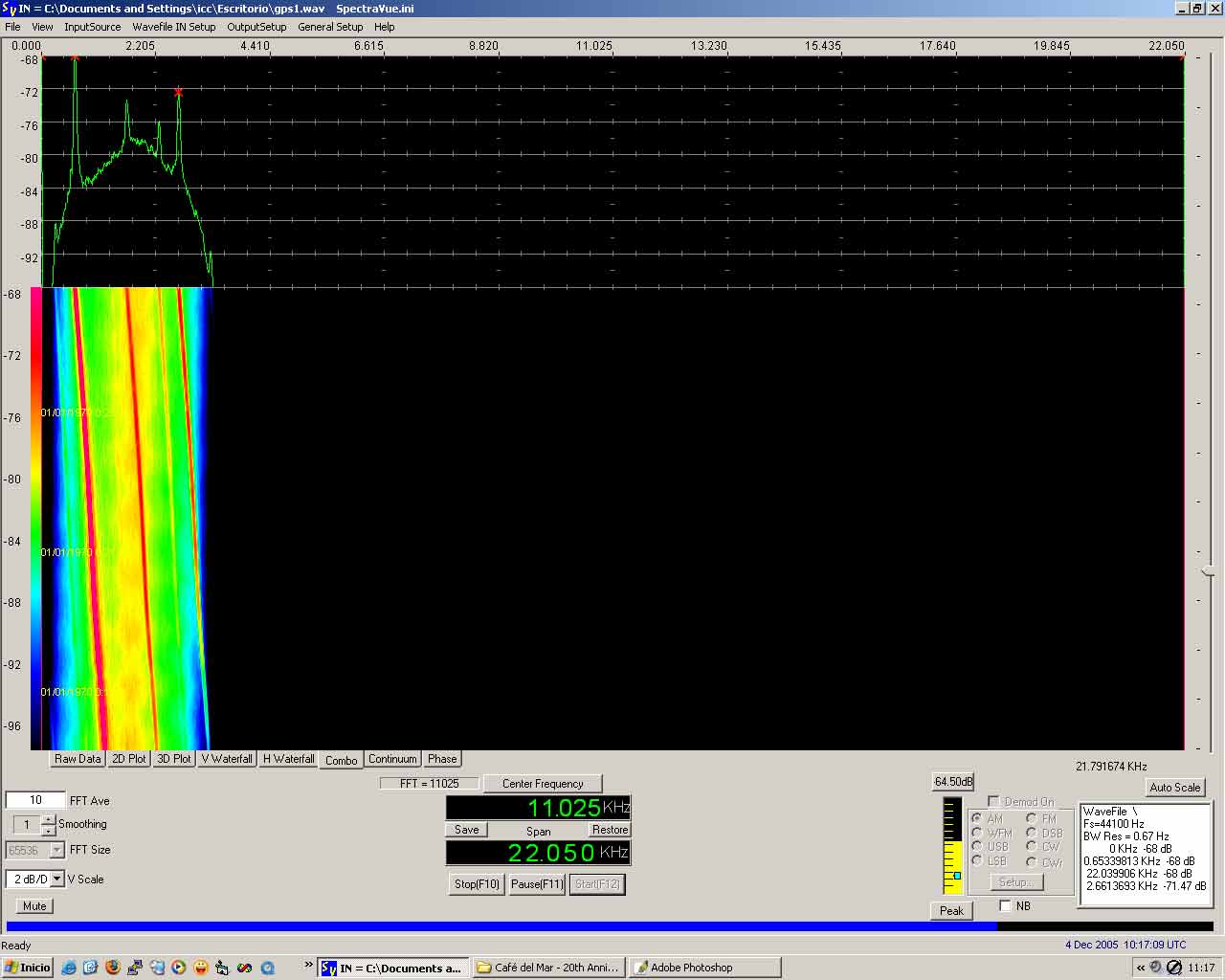
Random radio background noise (static)
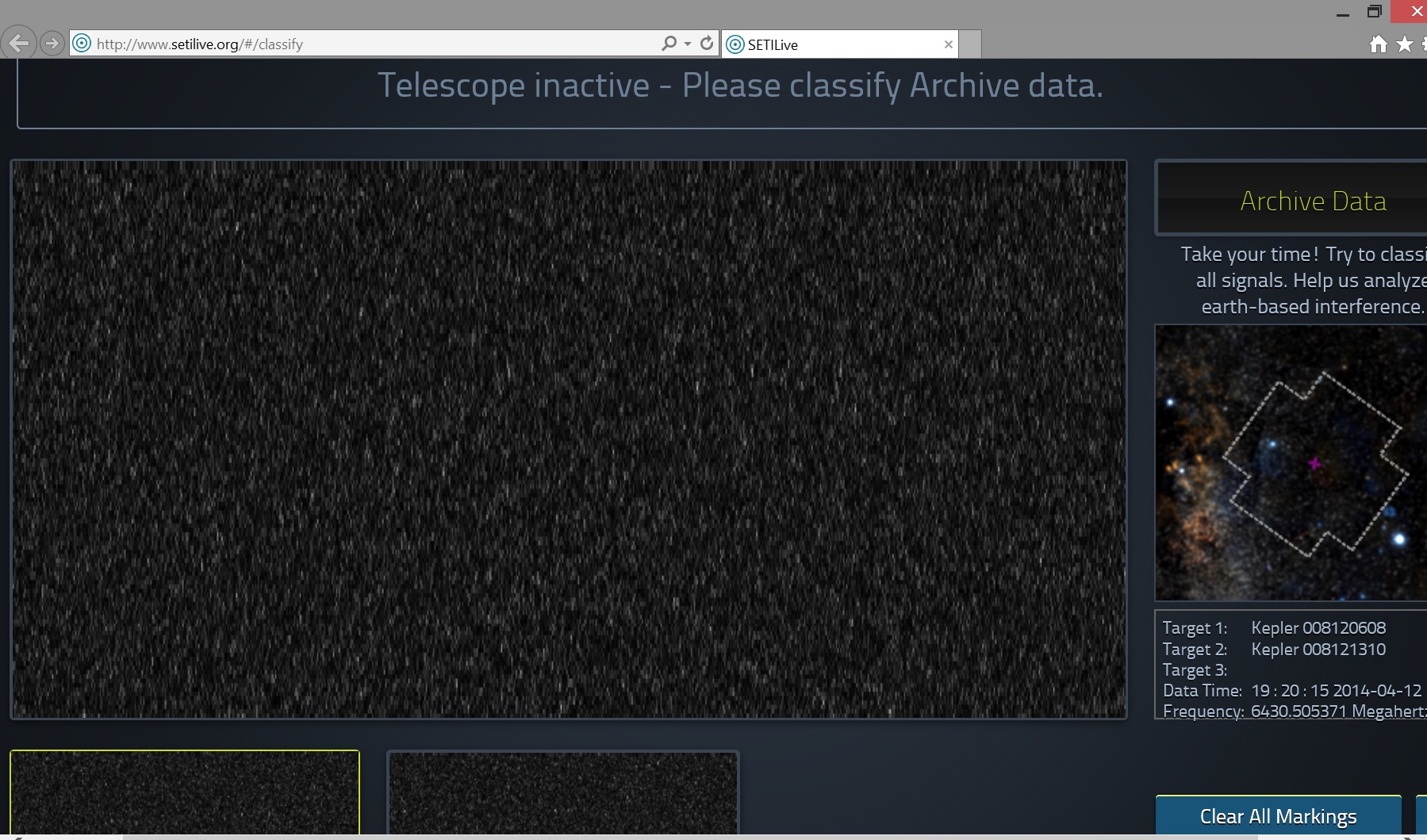
Radio signals from a pulsar
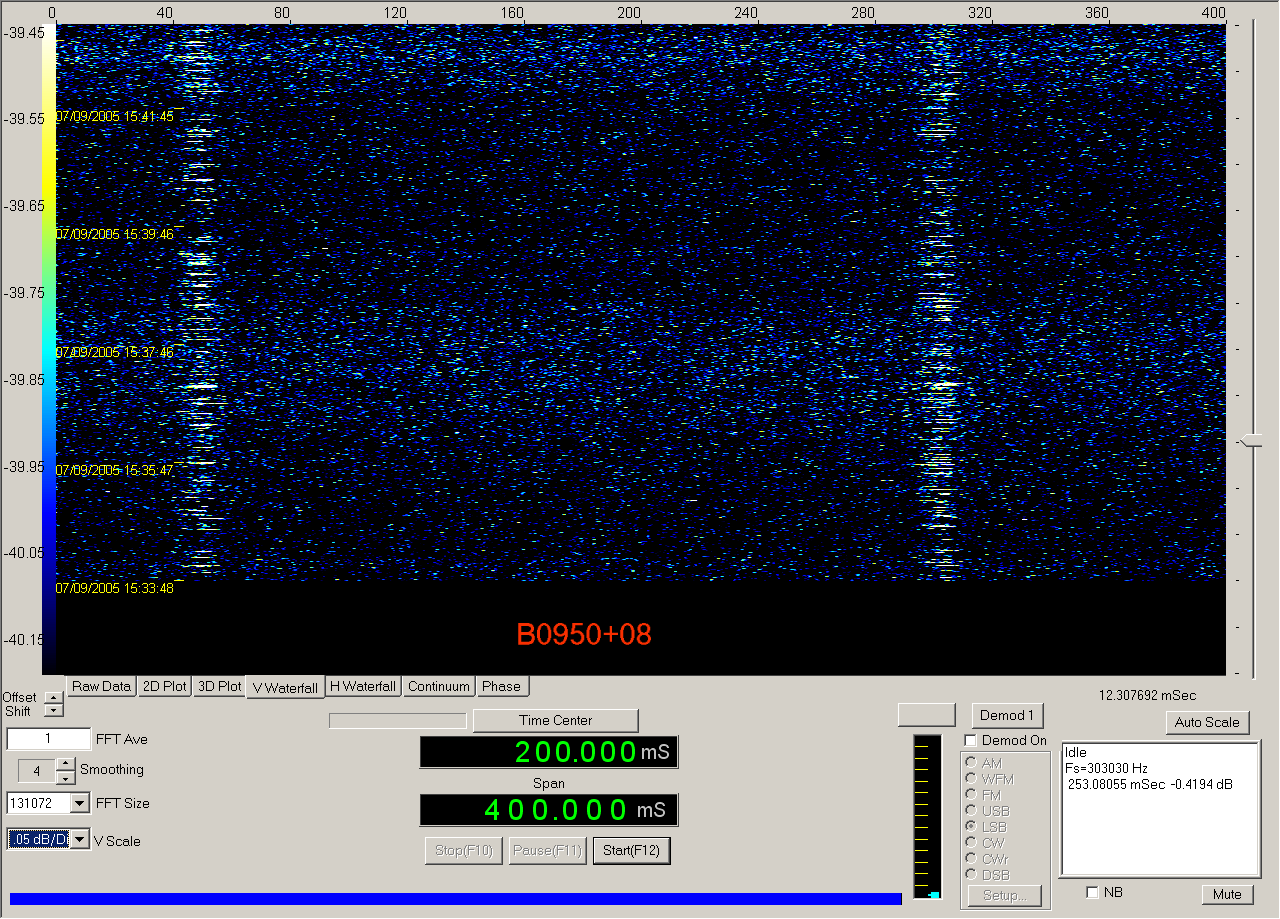
Radio signals from the Sun
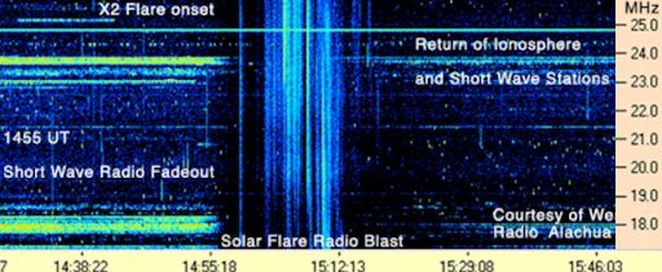
Radio signals from a Fast Radio Burst event

These fast radio bursts are pretty much noise, they contain no narrowband components nor information. No more than the static you hear on the radio from the spark plug in your car or when lightning strikes.
edit on 1-4-2015 by JadeStar because: (no reason given)
I'm not sure how this may fall into place but this caught my eye
Alexander Graham Bell
Maybe it's just a coincidence but there could be something more.... Perhaps they are finally trying to contact us
Michael Hippke of the Institute for Data Analysis in Neukirchen-Vluyn, Germany, and John Learned at the University of Hawaii in Manoa found that all 10 bursts' dispersion measures are multiples of a single number: 187.5 (see chart). This neat line-up, if taken at face value, would imply five sources for the bursts all at regularly spaced distances from Earth, billions of light-years away. A more likely explanation, Hippke and Lerned say, is that the FRBs all come from somewhere much closer to home, from a group of objects within the Milky Way that naturally emit shorter-frequency radio waves after higher-frequency ones, with a delay that is a multiple of 187.5 (arxiv.org/abs/1503.05245).
Alexander Graham Bell
On June 2, 1875, while working in one room with their experimental telegraphic device, Watson tried to free a reed that had been too tightly wound around the pole of its electromagnet. He inadvertently plucked the reed, which produced a twang that Bell heard on a second device in another room. This discovery led Bell to change his focus from improving the telegraph to figuring out a way to realize the potential for voice transmissions
Maybe it's just a coincidence but there could be something more.... Perhaps they are finally trying to contact us
originally posted by: JadeStar
originally posted by: bullcat
originally posted by: JadeStar
originally posted by: 1ofthe9
www.newscientist.com...
Paging JadeStar. Benford beacon type stuff?
No. Artificially produced radio signals would be narrow band because they allow the easy encoding/decoding of information.
Narrow band signals are not produced by nature so they'd pop out as not natural even after travelling hundreds of thousands of lightyears. Useful for a beacon.
Fast radio bursts are wide-band noise, like the other radio noise natural objects like lightning, the Sun and Jupiter produce.
Nature produces lots of wide-band noise type radio "signals". Fast radio bursts, like pulsars before them are almost certainly produced by some sort of natural object like neutron stars, colliding black holes, etc.
There have already been several threads in the Space Exploration forum on ATS on Fast Radio Bursts where I discussed this. Most recently, this one.
Not if it is using spread spectrum. The point of spread spectrum is to have signals appear as background noise so not to interfere with other signals on the same bands, that is why the early WiFi mandated the use of Spread Spectrum in the early days.
Spread spectrum still contains a narrowband component carrier. (Actually many of them).
See the waterfall plots below to see this visualized:
These fast radio bursts are pretty much noise, they contain no narrowband components nor information. No more than the static you hear on the radio from the spark plug in your car or when lightning strikes.
Ah nuts.
At least I'm picking up tons of cool stuff about radio. Didn't know we had a space exploration forum - I'll have to swing by...
If it is from other life forms..I for one don't think we should answer...
originally posted by: 1ofthe9
originally posted by: JadeStar
originally posted by: bullcat
originally posted by: JadeStar
originally posted by: 1ofthe9
www.newscientist.com...
Paging JadeStar. Benford beacon type stuff?
No. Artificially produced radio signals would be narrow band because they allow the easy encoding/decoding of information.
Narrow band signals are not produced by nature so they'd pop out as not natural even after travelling hundreds of thousands of lightyears. Useful for a beacon.
Fast radio bursts are wide-band noise, like the other radio noise natural objects like lightning, the Sun and Jupiter produce.
Nature produces lots of wide-band noise type radio "signals". Fast radio bursts, like pulsars before them are almost certainly produced by some sort of natural object like neutron stars, colliding black holes, etc.
There have already been several threads in the Space Exploration forum on ATS on Fast Radio Bursts where I discussed this. Most recently, this one.
Not if it is using spread spectrum. The point of spread spectrum is to have signals appear as background noise so not to interfere with other signals on the same bands, that is why the early WiFi mandated the use of Spread Spectrum in the early days.
Spread spectrum still contains a narrowband component carrier. (Actually many of them).
See the waterfall plots below to see this visualized:
These fast radio bursts are pretty much noise, they contain no narrowband components nor information. No more than the static you hear on the radio from the spark plug in your car or when lightning strikes.
Ah nuts.
At least I'm picking up tons of cool stuff about radio. Didn't know we had a space exploration forum - I'll have to swing by...
You should. The ATS Space Exploration forum is one of the best forums on ATS. It's where I hang out mostly and where most of the serious discussion of the possibility of ET, Alien life, Interstellar Travel and habitable exoplanets goes on.
Search some threads by stormbringer and I over there.
BTW: The fast radio burst story is being discussed over there again, here is my latest response: www.abovetopsecret.com...
edit on 2-4-2015 by JadeStar because: (no reason given)
new topics
-
Kirkpatrick vs Fugal - Skinwalker ranch briefing.
Aliens and UFOs: 2 hours ago -
Lemon-aid and lime-aid
General Chit Chat: 3 hours ago -
Multipal Solar Storms Coming Our Way This Weekend
Fragile Earth: 3 hours ago -
US food sources declining becoming non edible .
Social Issues and Civil Unrest: 5 hours ago -
Journalism Against Judaism
Middle East Issues: 11 hours ago
top topics
-
Bibi’s Dilemma
Middle East Issues: 15 hours ago, 11 flags -
US food sources declining becoming non edible .
Social Issues and Civil Unrest: 5 hours ago, 5 flags -
Multipal Solar Storms Coming Our Way This Weekend
Fragile Earth: 3 hours ago, 5 flags -
Journalism Against Judaism
Middle East Issues: 11 hours ago, 4 flags -
Lemon-aid and lime-aid
General Chit Chat: 3 hours ago, 2 flags -
Kirkpatrick vs Fugal - Skinwalker ranch briefing.
Aliens and UFOs: 2 hours ago, 1 flags
active topics
-
Judge Postpones Trump Classified Docs Trial INDEFINITELY
US Political Madness • 173 • : Asher47 -
Pentagon UFO Hunter Reveals What He Knows About Aliens: Nothing
Aliens and UFOs • 16 • : Ophiuchus1 -
The Acronym Game .. Pt.3
General Chit Chat • 7819 • : bally001 -
Multipal Solar Storms Coming Our Way This Weekend
Fragile Earth • 10 • : VariedcodeSole -
-@TH3WH17ERABB17- -Q- ---TIME TO SHOW THE WORLD--- -Part- --44--
Dissecting Disinformation • 914 • : daskakik -
President Bidens Health is Declining Faster 5.8.2024 - He Should Stay Home.
2024 Elections • 29 • : budzprime69 -
Kirkpatrick vs Fugal - Skinwalker ranch briefing.
Aliens and UFOs • 1 • : NoCorruptionAllowed -
Lemon-aid and lime-aid
General Chit Chat • 6 • : randomtangentsrme -
Ooooh...it worked!!
Members • 25 • : LandofEnchantment -
Candidate TRUMP Now Has Crazy Judge JUAN MERCHAN After Him - The Stormy Daniels Hush-Money Case.
Political Conspiracies • 1452 • : CarlLaFong
9
